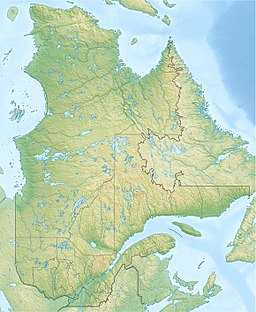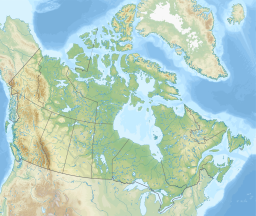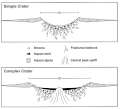geo.wikisort.org - Reservoir
Manicouagan Reservoir (also Lake Manicouagan) is an annular lake in central Quebec, Canada, covering an area of 1,942 km2 (750 sq mi). The lake island in its centre is known as René-Levasseur Island, and its highest point is Mount Babel. The structure was created 214 (±1) million years ago, in the Late Triassic, by the impact of a meteorite 5 km (3 mi) in diameter. The lake and island are clearly seen from space and are sometimes called the "eye of Quebec". The lake has a volume of 137.9 km3 (33.1 cu mi).[1][2]
| Manicouagan Reservoir | |
|---|---|
 View from orbit | |
| Location | Rivière-aux-Outardes, Manicouagan RCM Rivière-Mouchalagane, Caniapiscau RCM, Quebec |
| Coordinates | 51°07′38″N 68°44′50″W |
| Lake type | annular lake, reservoir |
| Primary outflows | Manicouagan River |
| Catchment area | 29,241 km2 (11,290 sq mi) |
| Basin countries | Canada |
| Surface area | 1,942 km2 (750 sq mi) |
| Average depth | 85 m (279 ft) |
| Max. depth | 350 m (1,150 ft) |
| Water volume | 137.9 km3 (33.1 cu mi)[1] |
| Residence time | 8 years |
| Shore length1 | 1,322 km (821 mi) |
| Surface elevation | 342 to 359 m (1,122 to 1,178 ft) (Dates: 1980 to 2005) |
| Islands | René-Levasseur Island, minor islets |
| 1 Shore length is not a well-defined measure. | |
Geography

The reservoir is located in Manicouagan Regional County Municipality in the Côte-Nord region of Quebec, Canada,[3] about 300 km (190 mi) north of the city of Baie-Comeau, although its northernmost part is located in Caniapiscau Regional County Municipality. Quebec Route 389 passes the eastern shore of the lake.
The crater is a multiple-ring structure about 100 km (60 mi) across, with the reservoir at its 70 km (40 mi) diameter inner ring being its most prominent feature. It surrounds an inner island plateau called René-Levasseur Island and Mount Babel is the highest peak of the island, at 952 m (3,123 ft) above sea level and 590 m (1,936 ft) above the reservoir level. The Louis-Babel Ecological Reserve makes up the central part of the island.
Impact crater
| Manicouagan Reservoir impact crater | |
|---|---|
| Impact crater/structure | |
| Confidence | Confirmed |
| Diameter |
|
| Impactor diameter | 5 km (3.1 mi) |
| Age | 214 ± 1 Ma |
Manicouagan Reservoir lies within the remnant of an ancient eroded impact crater (astrobleme). The crater was formed following the impact of an asteroid with a diameter of 5 km (3 mi), which excavated a crater originally about 100 km (62 mi) wide, although erosion and deposition of sediments have since reduced the visible diameter to about 72 km (45 mi). It is the Earth's sixth-largest confirmed impact crater according to rim-to-rim diameter.[4] Mount Babel is interpreted as the central peak of the crater, formed by post-impact uplift.
It is one of the oldest known impact craters. 1992 radiometric dating has estimated that impact melt within the crater has an age of 214 ± 1 million years. A later estimate found an age of 215.4 ± 0.16 Ma.[5] As this is more than 12 million years before the end of the Triassic, the impact that produced the crater cannot have been the cause of the Triassic–Jurassic extinction event.[6][7]
Multiple impact event claims
It was suggested that the Manicouagan crater may have been part of a multiple impact event which also formed the Rochechouart impact structure in France, the Saint Martin crater in Manitoba, the Obolon' crater in Ukraine, and the Red Wing crater in North Dakota. David Rowley, a geophysicist, with the University of Chicago, working with John Spray of the University of New Brunswick and Simon Kelley of the Open University, discovered that the five craters appeared to form a chain, indicating the breakup and subsequent impact of an asteroid or comet,[8] similar to the well observed string of impacts of Comet Shoemaker–Levy 9 on Jupiter in 1994.[9] However, more recent work has found that the craters formed many millions of years apart, with the Saint Martin crater dating to 227.8 ± 1.1 Ma.[10] While the Rochechouart structure formed 206.92 ± 0.20/0.32 Ma.[11]
Hydroelectric project

The Manicouagan Reservoir as it presently exists was created in the 1960s, by flooding the earlier Lake Mushalagan (Mouchalagan) to the west of the central plateau and then-smaller Manicouagan to the east, by construction of the Daniel-Johnson dam.[12] The works were part of the enormous Manicouagan or Manic series of hydroelectric projects undertaken by Hydro-Québec, the provincial electrical utility. The complex of dams is also called the Manic-Outardes Project because the rivers involved are the Manicouagan and the Outardes.
The reservoir acts as a giant headpond for the Manicouagan River, feeding the Jean-Lesage generating station (Manic-2), René-Lévesque generating station (Manic-3), and Daniel-Johnson Dam (Manic-5) generating stations downstream. In the peak period of the winter cold, the lake surface is usually lower, since the turbines run all the time at peak load to meet the huge electrical heating needs of the province. The surface of the lake also experiences low levels in the extreme periods of heat in New England during the summer, since in that period Hydro-Québec sells electrical energy to the joint New England grid and individual utilities in the United States.
See also
- Manicouagan Uapishka Biosphere Reserve
- List of possible impact structures on Earth
- Wembo-Nyama ring structure
References
- Hydro-Québec - Cinq principaux réservoirs d'Hydro-Québec
- Briney, Amanda. "The World's Top Ten Largest Reservoirs by Volume". About.com. Retrieved 19 August 2010.
- "Manicouagan". Earth Impact Database. Planetary and Space Science Centre University of New Brunswick Fredericton. Retrieved 19 August 2009.
- "Impact Structures listed by Diameter (Increasing)". PASSC. Retrieved 30 January 2020.
- Jaret, Steven J.; Hemming, Sidney R.; Rasbury, E. Troy; Thompson, Lucy M.; Glotch, Timothy D.; Ramezani, Jahandar; Spray, John G. (1 November 2018). "Context matters – Ar–Ar results from in and around the Manicouagan Impact Structure, Canada: Implications for martian meteorite chronology". Earth and Planetary Science Letters. 501: 78–89. doi:10.1016/j.epsl.2018.08.016. ISSN 0012-821X.
- Hodych, J.P.; G.R.Dunning (1992). "Did the Manicouagan impact trigger end-of-Triassic mass extinction?". Geology. 20 (1): 51.54. Bibcode:1992Geo....20...51H. doi:10.1130/0091-7613(1992)020<0051:DTMITE>2.3.CO;2.
- Ramezani, J., S. A. Bowring, M. S. Pringle, F. D. Winslow, III, and E. T. Rasbury (2005). "The Manicouagan impact melt rock: a proposed standard for intercalibration of U-Pb and 40Ar/39Ar isotopic systems". 15th V.M. Goldsmidt Conference Abstract Volume, p. A321.
- Spray, John G.; Kelley, Simon P.; Rowley, David B. (1998). "Evidence for a late Triassic multiple impact event on Earth". Nature. 392 (6672): 171–173. doi:10.1038/32397.
- Steele, Diana (19 March 1998). "Crater chain points to impact of fragmented comet". University of Chicago Chronicle.
- Schmieder, Martin; Jourdan, Fred; Tohver, Eric; Cloutis, Edward A. (November 2014). "40Ar/39Ar age of the Lake Saint Martin impact structure (Canada) – Unchaining the Late Triassic terrestrial impact craters". Earth and Planetary Science Letters. 406: 37–48. doi:10.1016/j.epsl.2014.08.037.
- Cohen, Benjamin E.; Mark, Darren F.; Lee, Martin R.; Simpson, Sarah L. (August 2017). "A new high-precision 40 Ar/ 39 Ar age for the Rochechouart impact structure: At least 5 Ma older than the Triassic-Jurassic boundary". Meteoritics & Planetary Science. 52 (8): 1600–1611. doi:10.1111/maps.12880.
- "Manicouagan Impact Structure". Crater Explorer. Retrieved 25 April 2017.
External links
- Manicouagan at Earth Impact Database
- Manicouagan Impact Structure at Crater Explorer
- Rowley, David. "Paleogeographic Atlas Project: Pictures". Paleogeographic Atlas Project. University of Chicago. Archived from the original on 18 June 2007. Retrieved 14 June 2013.
- NASA Astronomy Picture of the Day: Manicouagan Impact Crater on Earth (13 December 2000)
- Manicouagan Impact Crater from Space (2019 May 2)
- Aurora and Manicouagan Crater from the Space Station (2018 May 29)
На других языках
[de] Manicouagan-Stausee
Der Manicouagan-Stausee (französisch Réservoir Manicouagan, auch Lac Manicouagan genannt) ist ein ringförmiger See innerhalb eines Einschlagkraters in der Region Côte-Nord der kanadischen Provinz Québec.- [en] Manicouagan Reservoir
[es] Lago Manicouagan
El lago Manicouagan (también conocido como embalse Manicouagan) es un lago anular alimentado por las aguas del río Manicouagan y situado en el centro de Quebec (Canadá). En su interior destaca una gran isla circular conocida como René-Levasseur, cuyo punto más alto es el Monte Babel. Tanto el lago como la isla son claramente visibles desde el espacio, razón por la que reciben el nombre de "ojo de Quebec". El lago es accesible a través de la carretera Quebec Route 389, que discurre junto a la orilla oriental.[fr] Réservoir Manicouagan
Le réservoir Manicouagan, aussi appelé lac Manicouagan, est un cratère météoritique qui a été inondé par l'édification du barrage Daniel-Johnson sur la rivière Manicouagan. Situé dans la région administrative de la Côte-Nord, au Québec, le réservoir, d'une superficie de 2 000 kilomètres carrés et d'une profondeur moyenne de 73 mètres, est un des plus gros réservoirs du monde en volume et en profondeur. Il alimente les centrales hydroélectriques de Manic-5 et Manic 5-PA.[it] Lago Manicouagan
Il lago Manicouagan è un lago dalla forma di anello situato nelle regioni centrali della provincia canadese del Quebec. Il lago ha una superficie di 1942 km². L'isola al centro del lago è conosciuta con il nome di isola René-Levasseur che trova il suo punto più alto con il monte Babel. Il lago e isola sono chiaramente individuabili dallo spazio e sono talvolta chiamati l'"occhio del Quebec."[ru] Маникуаган (водохранилище)
Маникуа́ган[1] или Маникуаганское водохранилище (англ. Manicouagan Reservoir) — кольцеобразное озеро, расположенное на Лаврентийской возвышенности в центральной части провинции Квебек, Канада. Находится в метеоритном кратере с одноимённым названием, имеет площадь 1942 км². В центре озера находится остров Рене-Левассёр, на котором расположена гора Вавилон (952 м). Озеро вместе с островом хорошо видны из космоса[2], из-за чего также имеют название «глаз Квебека». В 2007 году озеро Маникуаган было выдвинуто на проводимый телекомпанией CBC конкурс Семи чудес Канады.Другой контент может иметь иную лицензию. Перед использованием материалов сайта WikiSort.org внимательно изучите правила лицензирования конкретных элементов наполнения сайта.
WikiSort.org - проект по пересортировке и дополнению контента Википедии



